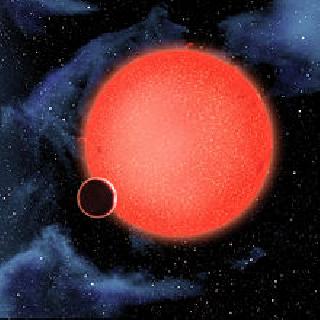
GJ1214b, shown in this artist's view, is a super-Earth orbiting a red dwarf star 40 light-years from Earth. Photo: NASA, ESA, and D. Aguilar (Harvard-Smithsonian Center for Astrophysics).
WASHINGTON (PTI): NASA's Hubble telescope has discovered clouds in the atmosphere of a super-Earth type planet 40-light years away, providing the first-ever weather forecast for a planet outside our solar system.
The scrutinised planet, known as GJ1214b, is classified as a super-Earth type planet because its mass is intermediate between those of Earth and Neptune.
Recent searches for planets around other stars have shown that super-Earths like GJ 1214b are among the most common type of planets in the Milky Way galaxy.
Because no such planets exist in our Solar System, the physical nature of super-Earths is largely unknown.
Previous studies of GJ 1214b yielded two possible interpretations of the planet's atmosphere: Its atmosphere could consist entirely of water vapour or some other type of heavy molecule, or it could contain high-altitude clouds that prevent the observation of what lies underneath.
But now a team of astronomers led by University of Chicago's Laura Kreidberg and Jacob Bean have detected clear evidence of clouds in the atmosphere of GJ 1214b from data collected with the Hubble Space Telescope.
The Hubble observations used 96 hours of telescope time spread over 11 months. This was the largest Hubble programme ever devoted to studying a single exoplanet.
The researchers describe their work as an important milestone on the road to identifying potentially habitable, Earth-like planets beyond our Solar System.
"We really pushed the limits of what is possible with Hubble to make this measurement," said Kreidberg, first author of the new study paper.
"This advance lays the foundation for characterising other Earths with similar techniques," said Kreidberg.
GJ 1214b is located just 40 light-years from Earth, in the direction of the constellation Ophiuchus. Because of its proximity to our solar system and the small size of its host star, GJ 1214b is the most easily observed super-Earth.
It transits, or passes in front of its parent star, every 38 hours, giving scientists an opportunity to study its atmosphere as starlight filters through it.
Kreidberg, Bean and their colleagues used Hubble to precisely measure the spectrum of GJ 1214b in near-infrared light, finding what they consider definitive evidence of high clouds blanketing the planet.
These clouds hide any information about the composition and behaviour of the lower atmosphere and surface.
The planet was discovered in 2009 by the MEarth Project, which monitors two thousand red dwarf stars for transiting planets.
The study was published in the journal Nature.
 Previous Article
Previous Article Next Article
Next Article













The Indian Air Force, in its flight trials evaluation report submitted before the Defence Ministry l..
view articleAn insight into the Medium Multi-Role Combat Aircraft competition...
view articleSky enthusiasts can now spot the International Space Station (ISS) commanded by Indian-American astr..
view article